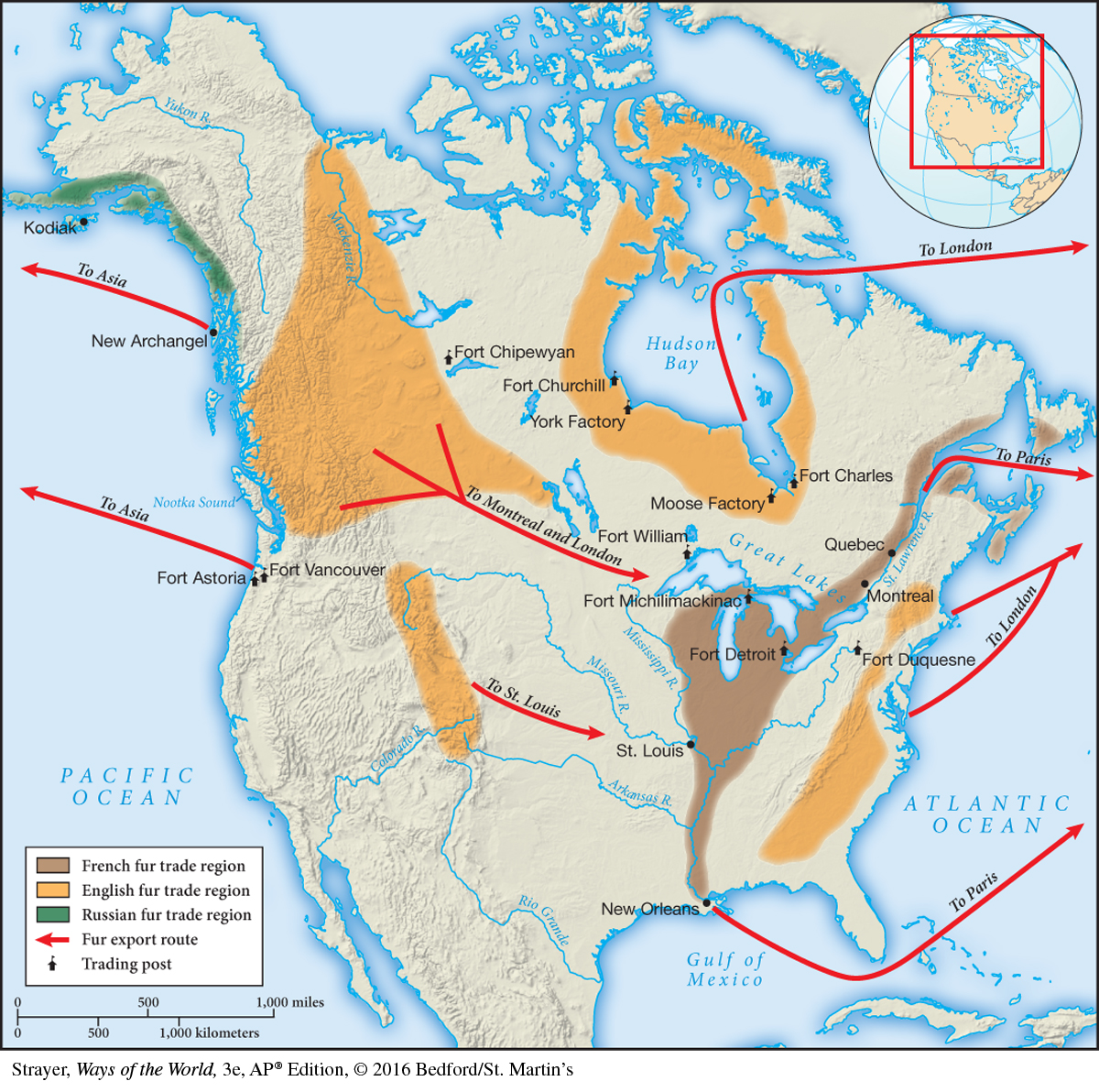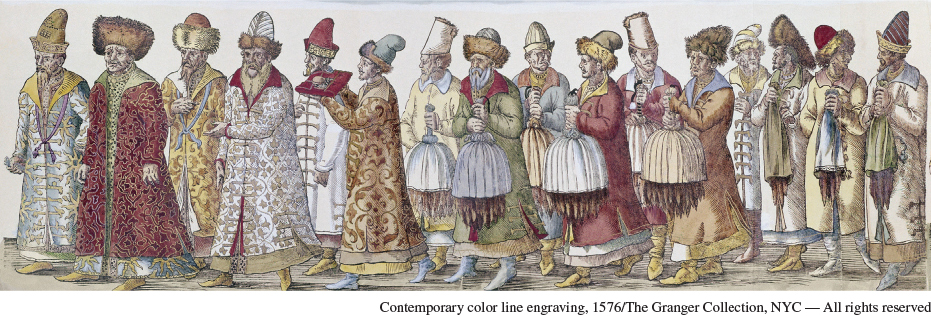“The World Hunt”: Fur in Global Commerce
In the early modern era, furs joined silver, textiles, and spices as major items of global commerce.18 Their production had an important environmental impact as well as serious implications for the human societies that generated and consumed them. Furs, of course, had long provided warmth and conveyed status in colder regions of the world, but the integration of North America and of northern Asia (Siberia) into a larger world economy vastly increased their significance in global trade.
Guided Reading Question
▪CHANGE
Describe the impact of the fur trade on North American native societies.
By 1500, European population growth and agricultural expansion had sharply diminished the supply of fur-bearing animals, such as beaver, rabbits, sable, marten, and deer. Furthermore, much of the early modern era witnessed a period of cooling temperatures and harsh winters, known as the Little Ice Age, which may well have increased the demand for furs. “The weather is bitterly cold and everyone is in furs although we are almost in July,” observed a surprised visitor from Venice while in London in 1604.19 These conditions pushed prices higher. The cost of a good-quality beaver pelt, for example, quadrupled in France between 1558 and 1611. This price increase translated into strong economic incentives for European traders to tap the immense wealth of fur-bearing animals found in North America. At the same time, the collapse of Native American populations in North America caused by the Great Dying led to the regrowth of forest habitats for fur-bearing animals and deer herds.
Like other aspects of imperial expansion, the fur trade was a highly competitive enterprise. The French were most prominent in the St. Lawrence valley, around the Great Lakes, and later along the Mississippi River; British traders pushed into the Hudson Bay region; and the Dutch focused their attention along the Hudson River in what is now New York. They were frequently rivals for the great prize of North American furs. In the southern colonies of British North America, deerskins by the hundreds of thousands found a ready market in England’s leather industry (see Map 14.3).

Only a few Europeans directly engaged in commercial trapping or hunting. They usually waited for Indians to bring the furs or skins initially to their coastal settlements and later to their fortified trading posts in the interior of North America. European merchants paid for the furs with a variety of trade goods, including guns, blankets, metal tools, rum, and brandy, amid much ceremony, haggling over prices, and ritualized gift giving. Native Americans represented a cheap labor force in this international commercial effort, but they were not a directly coerced labor force.
Over the three centuries of the early modern era, enormous quantities of furs and deerskins found their way to Europe, where they considerably enhanced the standard of living in those cold climates. The environmental price was paid in the Americas, and it was high. A consistent demand for beaver hats led to the near extinction of that industrious animal in much of North America by the early nineteenth century and with it the degradation or loss of many wetland habitats. Other fur-
You know our fathers had plenty of deer and skins and our plains were full of game and turkeys, and our coves and rivers were full of fish. But, brothers, since these Englishmen have seized our country, they have cut down the grass with scythes, and the trees with axes. Their cows and horses eat up the grass, and their hogs spoil our bed of clams; and finally we shall all starve to death.20
For the Native American peoples who hunted, trapped, processed, and transported these products, the fur trade bore various benefits, particularly at the beginning. The Hurons, for example, who lived on the northern shores of Lakes Erie and Ontario in the early seventeenth century, annually exchanged some 20,000 to 30,000 pelts, mostly beaver, and in return received copper pots, metal axes, knives, cloth, firearms, and alcohol. Many of these items were of real value, which strengthened the Hurons in their relationships with neighboring peoples. These goods also enhanced the authority of Huron chiefs by providing them with gifts to distribute among their followers. At least initially, competition among Europeans ensured that Native American leaders could negotiate reasonable prices for their goods. Furthermore, their important role in the lucrative fur trade protected them for a time from the kind of extermination, enslavement, or displacement that was the fate of native peoples in Portuguese Brazil.
Nothing, however, protected them against the diseases carried by Europeans. In the 1630s and 1640s, to cite only one example of many, about half of the Hurons perished from influenza, smallpox, and other European-borne diseases. Furthermore, the fur trade generated warfare beyond anything previously known. Competition among Native American societies became more intense as the economic stakes grew higher. Catastrophic population declines owing to disease stimulated “mourning wars,” designed to capture people who could be assimilated into much-diminished societies. A century of French-British rivalry for North America (1664–1763) forced Native American societies to take sides, to fight, and to die in these European imperial conflicts. Firearms, of course, made warfare far more deadly than before.
Beyond the fur trade, many Native American peoples sought actively to take advantage of the new commercial economy now impinging upon them. The Iroquois, for example, began to sell new products such as ginseng root, much in demand in China as a medicine. They also rented land to Europeans, worked for wages in various European enterprises, and started to use currency, when barter was ineffective. But as they became enmeshed in these commercial relationships, Native Americans grew dependent on European trade goods. Among the Algonquians, for example, iron tools and cooking pots replaced those of stone, wood, or bone; gunpowder weapons took the place of bows and arrows; European textiles proved more attractive than traditional beaver and deerskin clothing; and flint and steel were found to be more effective for starting fires than wooden drills. A wide range of traditional crafts were thus lost, while the native peoples did not gain a corresponding ability to manufacture the new items for themselves. Enthusiasm for these imported goods and continued European demands for furs and skins frequently eroded the customary restraint that characterized traditional hunting practices, resulting in the depletion of many species. One European observer wrote of the Creek Indians: “[They] wage eternal war against deer and bear … which is indeed carried to an unreasonable and perhaps criminal excess, since the white people have dazzled their senses with foreign superfluities.”21
Alongside germs and guns, yet another highly destructive European import was alcohol — rum and brandy, in particular. Whiskey, a locally produced grain-based alcohol, only added to the problem. With no prior experience of alcohol and little time to adjust to its easy availability, these drinks “hit Indian societies with explosive force.”22 Binge drinking, violence among young men, promiscuity, and addiction followed in many places. In 1753, Iroquois leaders complained bitterly to European authorities in Pennsylvania: “These wicked Whiskey Sellers, when they have once got the Indians in liquor, make them sell their very clothes from their backs…. If this practice be continued, we must be inevitably ruined.”23 In short, it was not so much the fur trade itself that decimated Native American societies, but all that accompanied it — disease, dependence, guns, alcohol, and the growing encroachment of European colonial empires.
All of this had particular implications for women. A substantial number of native women married European traders according to the “custom of the country” — with no sanction from civil or church authorities. Such marriages eased the difficulties of this cross-cultural exchange, providing traders with guides, interpreters, and negotiators. But sometimes these women were left abandoned when their husbands returned to Europe. More generally, the fur trade enhanced the position of men in their societies since hunting or trapping animals was normally a male occupation. Among the Ojibwa, a gathering and hunting people in the northern Great Lakes region, women had traditionally acquired economic power by creating food, utensils, clothing, and decorations from the hides and flesh of the animals that their husbands caught. With the fur trade in full operation, women spent more time processing those furs for sale than in producing household items, some of which were now available for purchase from Europeans. And so, as one scholar put it, “women lost authority and prestige.” At the same time, however, women generated and controlled the trade in wild rice and maple syrup, both essential to the livelihood of European traders.24 Thus the fur trade offered women a mix of opportunities and liabilities.

Paralleling the North American fur trade was the one simultaneously taking shape within a rapidly expanding Russian Empire, which became a major source of furs for Western Europe, China, and the Ottoman Empire. The profitability of that trade in furs was the chief incentive for Russia’s rapid expansion during the sixteenth and seventeenth centuries across Siberia, where the “soft gold” of fur-bearing animals was abundant. The international sale of furs greatly enriched the Russian state as well as many private merchants, trappers, and hunters. Here the silver trade and the fur trade intersected, as Europeans paid for Russian furs largely with American gold and silver.
Guided Reading Question
▪COMPARISON
How did the North American and Siberian fur trades differ from each other? What did they have in common?
The consequences for native Siberians were similar to those in North America as disease took its toll, as indigenous people became dependent on Russian goods, as the settler frontier encroached on native lands, and as many species of fur-bearing mammals were seriously depleted. In several ways, however, the Russian fur trade was unique. Whereas several European nations competed in North America and generally obtained their furs through commercial negotiations with Indian societies, no such competition accompanied Russian expansion across Siberia. Russian authorities imposed a tax or tribute, payable in furs, on every able-bodied Siberian male between eighteen and fifty years of age. To enforce the payment, they took hostages from Siberian societies, with death as a possible outcome if the required furs were not forthcoming. A further difference lay in the large-scale presence of private Russian hunters and trappers, who competed directly with their Siberian counterparts.
PRACTICING AP® HISTORICAL THINKING
What differences can you identify in the operation and impact of the spice, silver, and fur trades?